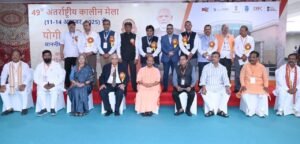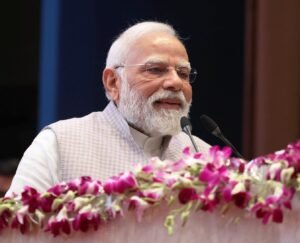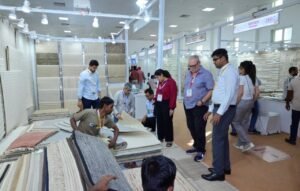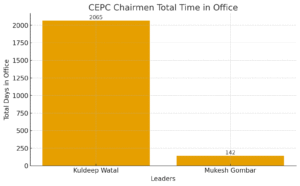CENTRAL VISTA- WEAVES 600 MILLION HAND KNOTS TO CARPET INDIA’S NEW PARLIAMENT

900 CRAFTSMEN FROM UP’S VILLAGES CREATE RECORD OF SORTS

The New Parliament Building will have hand-knotted carpets from Bhadohi, Uttar Pradesh popular for its beautiful hand-knotted carpets, earning it the name of ‘Carpet City’.
Renowned for the “knot-by-knot” technique, the beauty of the design comes from the way the knots are made by craftspersons in an intricate manner, using fingers.
This traditional and renowned craft of ‘knot by knot’ carpet making will add to the grandeur of the new building.
This project will further promote Bhadohi’s unique craft technique across the country, potentially increasing livelihood opportunities for the artisans. -MINISTRY OF HOUSING AND URBAN AFAIRE

LABOUR FOR 10 LAKH HOURS, WEAVES 600 MILLION HAND KNOTS TO CARPET INDIA’S NEW PARLIAMENT BUILDING WITH MOTIFS OF THE PEACOCK AND LOTUS

BHADOHI – Master craftsmen – hailing from tiny villages of India’s largest state – 800 kms from Delhi -carrying on a legacy dating back to Emperor Akbar himself, have created a record of sorts – to dress up India’s most iconic bastions of democracy.
In what is the greatest endorsement of Prime Minister Narendra Modi’s dream for India – an Atma Nirbhar Bharat (self-reliant), as many as 900 weavers from the districts of Bhadohi and Mirzapur in Uttar Pradesh have spent a whopping 10 lakh man hours to carpet India’s New Parliament building – both the houses of the Rajya Sabha and the Lok Sabha.
While the carpets of the Lok Sabha have the most intricate motifs of the peacock – symbolizing India’s national bird, those at the Rajya Sabha showcases the exquisite motifs of the national flower, the lotus. These carpets, adorned with meticulously crafted patterns and embellished with 20-25 shades, stand as a testament to India’s unparalleled artistry.
The New Parliament Building will be inaugurated by Prime Minister Modi on May 28. Obeetee’s weavers crafted 158 carpets for the Lok Sabha and 156 for the Rajya Sabha before stitching them into a single carpet in the form of a semi-circle to sync with the architecture of each of the Houses spread across 35,000 square feet of area.
The weaver’s used the laborious and ancient art of hand knotting to create the magnificent masterpieces.
The intricacies of the workmanship is so grand that as many as 120 knots per square inch were woven to create the carpets – amounting to over 600 million knots approximately in total.
Obeetee officials say the weavers belonged to the villages of Lala Nagar, Deharia, Jangipur, Pipanith, Goppur, Ugapur, Anarudidhapur, Fattapur, Godhana, Kalhana, Makrandpur, Abholi, Guwali, Meuli, Bathna, Gazia, Chausha, Barkaccha, Aghuli and Fataha.
According to Rudra Chatterjee, Chairman, Obeetee carpets, the mammoth exercise to create the magnificent carpets for the Parliament took over a year and a half, beginning in 2020. He said that Obeetee is inclusive and diverse in its workforce. Women weavers were an integral part of this historic project.
Chatterjee said “We began the project in 2020 right in the middle of the pandemic. The weaving process started by September 2021, was over by May, 2022, and the installation commenced in November 2022. Crafting each carpet with a high density of 120 knots per square inch took approximately 7 months. Being entrusted with the Central Vista project is an incredible honour for us at Obeetee”.
“The carpet designs were conceived with great reverence for the halls, exuding intricate artistry, vibrant colours, and subtle elegance. Crafted at Obeetee’s own factory headquarters in Mirzapur, the manufacturing procedure was a tedious process as the weavers had to craft the carpets for halls measuring up to 17,500 square feet each. This posed a significant challenge for the design team, as they had to meticulously craft the carpet in separate pieces and seamlessly join them together, ensuring that the creative mastery of the weavers blended harmoniously to create a unified carpet that can sustain heavy footfall,” he added
While the colours used in the Rajya Sabha has been primarily inspired by the shade of Kokum Red, the look of the Lok Sabha is based on Indian agave green, with inspirations from the plumes of the Indian peacock.
As the story goes, Emperor Akbar known to be a connoisseur of beautiful things had an exceptional fondness for carpets and decided to bring the finest Persian an artists and weavers to India, nearly five centuries ago. During that journey,
when they reached Gopiganj, a small town in modern Uttar Pradesh, their caravan was attacked by bandits.The weavers that survived that slaughter took shelter in villages around that area, making Mirzapur – the Mecca of carpet weaving
Obeetee was founded around 103 years ago by three British entrepreneurs, soon after World War 1 – the name of the company resembling the initials of their three names.
Today, Obeetee has become the most venerable address for the world’s finest and most intricate carpets and rugs – working with over 20,000 artisans of the region – mastercraftsman who can tie up to 9,000 knots a day, so intricate that it ranges from 15 knots to 300 knots per square inch, sometimes taking a year’s laborious work.
Two of Obeetee’s carpets adorn India’s greatest residential address – The Rashtrapati Bhawan – one of which measure over 450 square metres and contains a whopping 100 million intricate knots.
The need for a New Parliament House stemmed from the fear of stability of the existing Parliament building which is around 100 years old – inaugurated on January 1927 by Edwin Lutyens and Herbert Baker.
The new building – shaped like a triangle – with an expected lifespan of 150 years will have 1272 seats of which 888 are reserved for Lok Sabha and 384 seats for Rajya Sabha. According to government officials, the present Parliament building was never designed to accommodate a bicameral legislature for a full-fledged democracy. The number of Lok Sabha seats has remained unaltered at 545 based on the delimitation carried out on the basis of 1971 Census. It is likely to increase substantially after 2026 as the freeze on total number of seats is only till 2026.
They said “The seating arrangements are cramped and cumbersome, with no desks beyond the second row. The Central Hall has seating capacity only for 440 persons. When the Joint Sessions are held, the problem of limited seats amplifies. Due to limited space for movement, it is also a huge security risk”.






